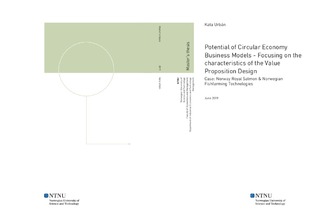| dc.description.abstract | Sustainable, environmentally friendly and circular way of thinking in aquaculture is essential to meet the Sustainable Development Goals (SDGs) and challenges linked to global food production, growing population, endangered and fragile ecosystem and climate change.
Developing and trying to adopt such ideas and theories as circular economy and circular business model could help to achieve the SDGs and build a better future for the next generations. Different ways of running a business and creating value has emerged among the different industries and in the aquaculture industry too. This trend could be seen in Norway as well, where traditional businesses are trying to become more sustainable, environmentally friendly, and socially responsible.
Salmon farming as one of the largest industries in Norway has a significant impact on the Norwegian economy. Aquaculture plays an essential part in the global food system, because of the seafood and because of the role of seas in the ecosystem. The country is a pioneer in the sector worldwide. That is why it is important, how they approach the production and how they define their values or work through the supply chain. If the Norwegian companies develop standards and work towards more sustainable solutions, the competitors must work on their own sustainability as well and they could contribute to a greater purpose, called circular economy.
Circular economy is one of those concepts that could help to slow the climate crisis down and develop new solutions to slowly accommodate to the new circumstances posed by climate change related challenges. Circular Economy would turn goods and products that are at the end of their service life into resources, while closing loops in industrial ecosystems and minimizing waste. (Stahel, 2016) Circular economy is about closing loops, reusing what we have and producing goods in a more conscious and sustainable way, where lifecycle of the produced good is known. In some sense and understandings, circular economy could be the endgame of achieving the Sustainable Development Goals. SDGs could play a significant part in the transformation from linear economy towards circular. Every goal has a different approach how to sustain life on Earth and how to make everyone equal in every sense of the term. However, these goals are diverse and in some cases too general to personalize them for businesses. Circular Economy Business Models (CEBMs) can break the vicious circle of prioritizing immediate needs over long-term considerations in poverty that can cause environmental degradation, leading to reduced income opportunities, increased poverty and vulnerability. (Lüdeke‐Freund, Gold, & Bocken, 2019)
The aim of this study is to develop a Value Proposition Design for Circular Economy Business Models and to present if this is necessary to have a new value proposition design after a transition from a traditional business model to a circular one or not. The study tries to illustrate its results through two demonstrative case studies of Norway Royal Salmon and Norwegian Fishfarming Technologies and they show what kind of challenges appear in primary industries from the perspective of circular economy and in the terms of value proposition design. | |
